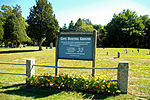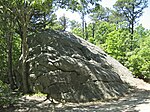Eastham Center Historic District

The Eastham Center Historic District is a historic district encompassing the main village center of Eastham, Massachusetts. This village center grew around the railroad station, which was built in 1870. The arrival of the railroad resulted in a shift of economic and civic activity from the old town center, a short way to the north. Prominent buildings in the district include the Town Hall (2500 State Highway), a Colonial Revival structure built in 1912, the Library (190 Samoset Road), built in 1897, and the Universalist Chapel (220 Samoset Road), built 1889. The main focal point of the district is Windmill Park, location of the Eastham Windmill, built c. 1680 and moved to Eastham in the 1790s; it is the oldest windmill on Cape Cod. The district was added to the National Register of Historic Places in 1999.
Excerpt from the Wikipedia article Eastham Center Historic District (License: CC BY-SA 3.0, Authors, Images).Eastham Center Historic District
Van Dale Avenue,
Geographical coordinates (GPS) Address Nearby Places Show on map
Geographical coordinates (GPS)
| Latitude | Longitude |
|---|---|
| N 41.827777777778 ° | E -69.973333333333 ° |
Address
Van Dale Avenue 35
02642
Massachusetts, United States
Open on Google Maps










